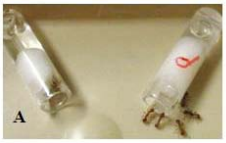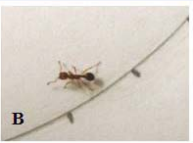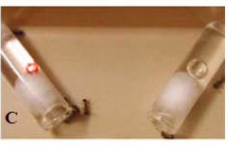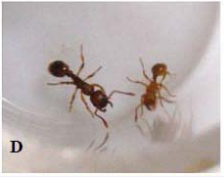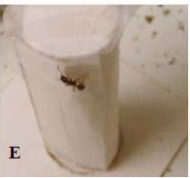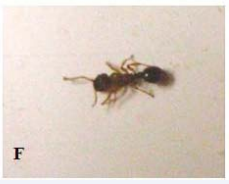Ants as Models for Examining Potential Adverse Effects of Products Used By Humans
- 1. Department of Biology of Organisms, University of Brussels, Belgium
Abstract
The present paper follows that, published in 2016 in the same journal, which showed that ants can be used as models for studying the effects of products consumed by humans and briefly reported the effects of 20 products. Having continued such studies, we here summarize the effects of nine newly examined products, an antidepressant, two statins, three analgesics, glutathione, aluminum foil and aluminum hydroxide. Comparisons are made between products having similar medical effects. Reader will thus be able to estimate the safety of each of these products, and to use them consequently.
Keywords
Brain functioning, Dependence, Drug, Locomotion, Memory
Citation
Cammaerts MC (2018) Ants as Models for Examining Potential Adverse Effects of Products Used By Humans. JSM Anat Physiol 3(1): 1016.
INTRODUCTION
We have many times explained that animals are used as models for studying humans’ physiological and ethological problems, that invertebrates are advantageously used, and that ants can be excellent models due to their sophisticated social life, evolved cognition and easy maintenance in a laboratory [1 and references therein]. In a previous paper [1], we briefly explained the adverse effects of 20 products used by humans (i.e. five alkaloids, three antidepressants, five drugs, two anxiolytics, a food additive, and four sweeteners) and gave the references of the complete study for all these products.
In the present paper, we very shortly present our methodology and relate the adverse effects of nine products commonly used by humans who are often not correctly informed about the safety of these products. Some comparisons between examined products may help the consumers to adequately use these products.
MATERIAL AND METHODS
Maintenance of ants and feeding them with the product under investigation
Ants were maintained in glass tubes half-filled with water and set in trays the borders of which were covered with talc to prevent escaping. They received pieces of Tenebrio molitor larvae three times per week and had continuously at their disposal cotton plugged tubes containing sugar water. The humidity, temperature, lighting and electromagnetic field intensity were optimum for the used species. Details are given in previous papers [2,5, 7,9,11,13,15,17,19].
The studied species belonged to the genus Myrmica (M. rubra, M. ruginodis, M. sabuleti), the biology of which is presently rather well known since we have examined, among others, they eye morphology, visual perception, navigation, recruitment, as well as the ontogenesis of some of their knowhow, and several of their cognitive abilities (including their solving of problems, acquisition of novel behaviors, enabling to use tools, and their learning of a behavioral sequence).
The substances to be examined were given to the ants as a solution into their usual sugar water. The concentration of a product sugar solution was determined on the basis of the amount of this substance consumed per day by humans, and on the fact that ants as insects drink proportionally ten times less water than mammals, with the estimation that a human consume one liter of water per day. The ‘sugar + a product to be examined’ solution was refreshed and renewed as necessary.
Ants’ traits and their assessment
Twenty two ants’ physiological and/or ethological traits could be observed and assessed, 18 first on ants living under normal diet and then when consuming the product to be examined, and four other ones only on ants consuming or having consumed the product. The assessment of these 22 traits is summarized in [1], and somewhat detailed in each paper devoted to the study of given products [same references as above].
The 18 traits were the ants’ meat consumption, sugar water consumption, general activity, linear speed, angular speed, orientation towards an alarm signal, trail following, audacity, tactile perception, brood caring, aggressiveness against nestmates, aggressiveness against aliens, cognition, escaping ability, visual conditioning, visual memory, olfactory conditioning and olfactory memory. The four other traits were the ants’ adaptation to adverse effects of the product, habituation to its beneficial effect, dependence on the product consumption,and decrease of the effects of the product after its consumption was stopped.
Appropriate non-parametric tests were each time made on the numerical results, and photos of the most relevant experiments were provided to the readers.
RESULTS
Paroxetine
This drug is an antidepressant, an ‘ISRS’; it is the nowadays most used one, the previous being fluoxetine [2,3]. Paroxetine impacted the ants’ food consumption, activity and movement (erratic displacements, trembling). It decreased the ants’ orientation and trail following ability, tactile perception, brood caring, cognition, escaping behavior and, drastically, their middle term memory. It did not affect the ants’ short memory, increased their audacity, and made them aggressive against nestmates. Ants adapted themselves to some adverse effects of paroxetine, and became somewhat habituated to its antidepressant one. Ants developed dependence on paroxetine (Figure 1A),
Figure 1(A) : Six views of experiments. ants under paroxetine diet presenting dependence on that drug, i.e. preferentially drinking the sugar water containing it (red P).
the effects of which rapidly decreased during a few hours after weaning (what leaded to dependence), then slowly vanished in about 60 hours. Due to the dependence on and the habituation to the drug effect, humans may be inclined to go on consuming the drug and even to increase the ingested amount in the course of time. Attention must thus be paid to persons treated with paroxetine (see also comparison with fluoxetine in the ‘Discussion’ section).
Simvastatin
Simvastatin is an artificial, synthesized statin used for caring of persons suffering from hypercholesterolemia [4]. This use is nowadays debated [5]. Tested on ants as models, simvastatin appeared to increase their sugar water consumption, to decrease their activity, linear speed, orientation and trail following ability (Figure 1B),
Figure 1(B): an ant under statin diet departing from a circular trail, instead of following it.
audacity, tactile perception, cognition, escaping ability, visual and olfactory conditioning and memory (so their short and middle term memory). Simvastatin did not impact the ants’ social relationship, leaded to some adaptation, no habituation and no dependence. Consequently, even if this statin presented these four advantageous characteristics, it had many important adverse effects and should be used only in case of severe hypercholesterolemia.
Lovastatin
The red yeast of rice, a natural food complement, contains a natural statin labeled lovastatin which can reduce to some extend the amount of cholesterol of patients suffering from hypercholesterolemia [6,7]. This product slightly increased the ants’ sugar water consumption, slightly decreased their activity, trail following, tactile perception, cognition, escaping ability, as well as their visual and olfactory conditioning and memory. Lovastatin did not affect the ants’ orientation, audacity, brood caring and social relationship. Ants developed adaptation to some adverse effects of lovastatin, no habituation to and no dependence on this product, the effects of which slowly vanished in about 25 hours. As a matter of fact, lovastatin had some adverse effects of a rather low intensity, and could thus be used without excess, safely, for treating persons suffering from moderate hypercholesterolemia.
Paracetamol
Paracetamol, a largely used analgesic, duly reduced theants’ tactile perception [8]. However, it presented several adverse effects [9]. It increased the ants’ sinuosity of movement, decreased their orientation ability, trail following, cognition, visual and olfactory conditioning, as well as their visual and olfactory memory. It did not affect the ants’ food consumption, general activity, audacity and escape behavior. It also did not impact the ants’ brood caring and their aggressiveness against nestmates or aliens, so their social relationship. Slight adaptation occurred to its adverse effects, but a significant habituation to its analgesic effect occurred and obvious dependence appeared on its consumption (Figure 1C).
Figure 1(C): ants under paracetamol diet presenting dependence on that drug, i.e. drinking the sugar water containing it (red P).
Its effect rapidly decreased in 4 hours after its consumption was stopped, what was in agreement with the appearance of dependence on its consumption. Humans could effectively develop dependence on paracetamol and become inclined to consume it again, even increasing its ingested amount. Since the adverse effects of paracetamol depend on the ingested dose, and since this drug essentially impacts the central nervous system, it can be stated that paracetamol is not a fully safe analgesic.
Curcumin
This product, extracted from the rhizome of Curcuma longa, has a legendary analgesic effect [10], and had obviously such an effect on ants [11]. Spectacularly, it did not impact any of the 18 physiological and ethological examined ants’ traits. Moreover, it leaded to no habituation and to no dependence. After weaning, its analgesic effect persisted unchanged for 5 hours, then slowly decreased and vanished in a total of about 12 hours. We can thus conclude that this vegetal extract is a safe analgesic, which could be used at any time, during any time period, causing no health problem.
Ibuprofen
This drug is the nowadays most used analgesic [12]. It effectively decreased the ants’ tactile perception [13]. However, it decreased the ants’ food consumption, speed of locomotion, orientation ability and trail following. It impacted the ants’ audacity (forwardness), decreasing their moving on an unknown apparatus, through a small exit, and through a twists and turns path. It also affected the ants’ brood caring and aggressiveness against nestmates (Figure 1D)
Figure 1(D): two nestmates under ibuprofen diet presenting aggressive behavior, i.e. opening their mandibles.
and aliens. It did not affect the ants’ visual and olfactory conditioning, as well as their visual and olfactory memory. No adaptation occurred to its adverse effects, and habituation appeared to its analgesic property. Ants developed no dependence on its consumption, and after weaning, its effects slowly vanished in 10 hours. Consequently, ibuprofen decreased the ants’ appetite, perception and straightforwardness, impacted their social relationship, leaded to no adaptation, and to some habituation, what is not in favor of its use. However, it did not affect the ants’ cognition, learning and memory, and leaded to no dependence, what is in favor of its use. Though being not strongly dangerous, ibuprofen is however a not fully safe analgesic.
Glutathione
Glutathione is an antioxidant compound present in any cell [14]. It is nowadays provided to humans in any drugstore, as a food complement which allows ‘staying in good health’. Tested on ants as models [15], this product decreased these insects’ food consumption, increased their activity, speed of locomotion, audacity (Figure 1E),
Figure 1(E): an ant under glutathione diet having the audacity to climb on an unknown risky apparatus.
slightly their cognition, and slightly their condition capability and their memory. It induced no stress, and did not impact the ants’ tactile perception as well as their social relationship. Ants developed no adaptation to and no habituation to glutathione but acquired some dependence on it, the effect of which rapidly decreased between about 2 and 7 hours after weaning. Unexpectedly, this decrease was followed by a recovering time period during which the ants were less active. Glutathione should thus be used only momentarily. Consequently, on basis of its observed effects, it could be concluded that glutathione did not act as a strong drug such as cocaine, but acted as a doping substance which increased physical and cognitive performances. Humans may discover such a doping property and use glutathione for enhancing their performances at the expense of their health, a fear about which practitioners and concerned persons must be informed.
Aluminum foil
Aluminum foil is largely used for packaging and even for cooking food [16]. Is this use safe? Pieces of aluminum foil were set into the ants’ usual sugar water, and ants presented then several health problems [17]. Their activity, sinuosity of movement and sugar consumption were increased. Their meat consumption, audacity, tactile perception, cognition, escaping ability, conditioning capability and memory were reduced. Their social relationships were not affected. Ants presented no adaptation to and no dependence on the effects of aluminum foil. This product affects thus the individuals’ activity, locomotion and nervous system functioning. Being not correctly informed of this, humans go on largely using aluminum foil in their everyday life.
Aluminum hydroxide
This compound is used for reducing acidity present in the stomach [18]. Given to ants in their sugar water, it appeared to induce health problems similar to those produced by aluminum foil, but rather strongly [19]. The ants presented severe problems of locomotion (Figure 1F),
Figure 1(F): an ant under aluminum hydroxide diet presenting moving difficulties.
among others, and their activity was consequently reduced. Like for aluminum foil, no adaptation as well as no dependence occurred. Reducing the stomach acidity should therefore be obtained using drugs without aluminum hydroxide or natural (vegetal, mineral) alternatives.
DISCUSSION
We thus went on using ants as models for examining the effects of presently nine products largely used by humans. Our results were in agreement with those of researchers on the effects of these products on humans, and we brought new information on them, all this being useful for practitioners, pharmacists, as well as for any humans.
Let us compare the nowadays and the previously most used antidepressants, i.e. paroxetine and fluoxetine. Paroxetine affected the ants’ health, impacting among others their food consumption, activity, cognitive abilities, social relationship, and middle term memory, and leaded to some habituation and to dependence. When tested on ants as models just like paroxetine was tested, fluoxetine had physiological and ethological effects similar to but far stronger than those induced by paroxetine. Forinstance, the ants’ short term memory was also largely affected, and the aggressiveness against nestmates was so strong that ants even killed their brood. Paroxetine should thus be preferred to fluoxetine. However - and this is important - paroxetine leaded to habituation and dependence while fluoxetine did not do so. Consequently, although paroxetine should be used instead of fluoxetine (which is really too dangerous), patients must be carefully monitored in order to avoid the appearance of a dependence on paroxetine consumption. Contradiction between on one hand the wanted and obtained effects and, on the other hand the appearance of unwanted adverse effects, should not be silenced but taken into account for enacting research on the topic.
Let us consider the artificial simvastatin and the natural lovastatin. The former product is more efficient in reducing the amount of cholesterol. However, its adverse effects must be taken into account before preferring it to lovastatin. Indeed, the two statins presented similar adverse effects but lovastatin had less negative effects than simvastatin and these effects were less severe than those presented by simvastatin. Consequently, we propose to use lovastatin (the red yeast of rice) for caring of persons suffering from moderate hypercholesterolemia, and simvastatin only for those presenting a severe hypercholesterolemia. It should also be mentioned that only very high amounts of cholesterol, and not a slight excess, is harmful to health.
The comparison of the effects of paracetamol, ibuprofen and curcumin is very interesting. Indeed, the two first are very efficient analgesics but presented severe adverse effects, and these effects differed between each of these two drugs. On the other hand, curcumin is a somewhat less efficient analgesic but presented no adverse effect at all on ants. It might thus be proposed to use curcumin in case of moderate or momentary pain, and to use paracetamol and ibuprofen alternately, without excess, in case of strong pain. This should limit the impact of unsafe analgesics on the health. Let us add that perceiving pain is a vital function which informs the living organism that some health problem exists and must be taken into account. Any analgesic leads to some habituation. This results from a physiological adaptation of the organism for still correctly perceiving what occurs in itself even if its perception is reduced. The membrane of sensory cells enlarges, the number of sensitive sites increases, among others, in the same manner as reducing the light or the sound intensity leads to an adaptation of the concerned sensory organs (eyes, ears) and brain parts.
Attention must be paid as for the availability and the use of glutathione. This substance appeared to be clearly a doping substance on ants as models, and an internet site revealing such an effect has been visited more than 4,000 times, proving that many people has effectively found the doping property of glutathione and use it for this effect.
We estimate that it is important to divulgate the results obtaining about the effects of aluminum foil and aluminum hydroxide. These two products had similar adverse effects on ants, and those produced by aluminum hydroxide were stronger than those produced by aluminum foil. Each time, the effects were severe enough to prevent people using these products. Food cooking and packaging can be done using other materials than aluminum. Alternatives to aluminum hydroxide (used for reducing the stomach acidity) must be researched. We shall soon study the effects of such alternatives (calcium and magnesium carbonates). Note that only strong stomach acidity must be cared of, since this acidity, if not too painful, is natural and beneficial to the health.
General comments can now be made on basis of what we experienced all along our works. New products are sometimes proposed to humans without their potential harmful effects were carefully examined, or even after studies have been made, but the results of which being not or poorly divulgated [20]. The beneficial effects of such products are put forward, but their adverse ones are not at all, or incompletely, or not explicitly explained to consumers. We cannot but claim that each new drug, food additive, food complement and potentially useful product should be tested, at several doses, at least on animals and humans, and that the results should be honestly divulgated, being among others clearly summarized on their package or notice. If products present severe adverse effects, their availability should be reduced, limited and controlled.
Many artificial synthesized products largely used by humans nowadays contaminate natural water because they are not eliminated by the existing weeding systems [21]. Living organisms depending on surface water (essentially fishes, mollusks, aquatic insects) are or may be impacted by these products. Several studies have already been made. Anyway, to preserve intact the natural water and consequently tap water, other more efficient weeding systems should be researched and set in place, essentially in the surrounding of large humans’ urban areas.
To conclude, ants were proved to be very good biological models. They allowed confirming effects observed in humans, giving information on them, and revealing unknown ones which could appear in humans. Generally, anyone use products the adverse effects of which they do not exactly know because these effects have not well been divulgated or not fully examined, while the potential beneficial effects of the products have been put forward using different information systems. This situation should no longer be tolerated and should be revised. Studies on novel products must be honestly done, without conflict of interest, and their results clearly divulgated. If doing so, progresses in physiology and pharmacology are possible, discoveries often resulting from problems, contradictions, or previous mistakes and failures. Also, systems eliminating drugs and polluting products from waste water should imperatively be put in place.
ACKNOWLEDGEMENTS
Similarly to our previous summary [1], this one and the summarized works could never been realized without the help of R. Cammaerts and D. Cammaerts who made several statistical analysis, provided many references, corrected first versions of the papers, and helped me to finish works in due time.
REFERENCES
5. Cammaerts MC, Cammaerts D. Physiological effects of statines; a study on ants as models. A J Pharmaceu Res Health care. 2017; 9: 2250.
8. Pickering G, Loriot MA, Libert F, Eschalier A, Beaune P, Dubray C. Analgesic effect of acetaminophen in humans: first evidence of a central serotoninergic mechanism. Clinical Pharmacol Therap. 2006; 79: 371-378.
13.MC., Cammaerts R. Ethological. Ethological and physiological effects of the recently most used analgesic, ibuprofen; a study on ants as models. EC Pharmacol Toxicol. accepted.
14.Meister A, Anderson ME. Glutathione Ann Rev Biochem. 1983; 52: 711-760.
17.Cammaerts MC, Cammaerts R. Is metal leakage from aluminum foil without adverse effects? A study on ants as models. World J Nutrition and Health, in press.
19.Cammaerts MC, Cammaerts R. Some physiological and ethological effects of aluminum hydroxide; a study using ants as models. Acta Scient Pharmaceu Sci. 2018; 2 (3): 38-50.
